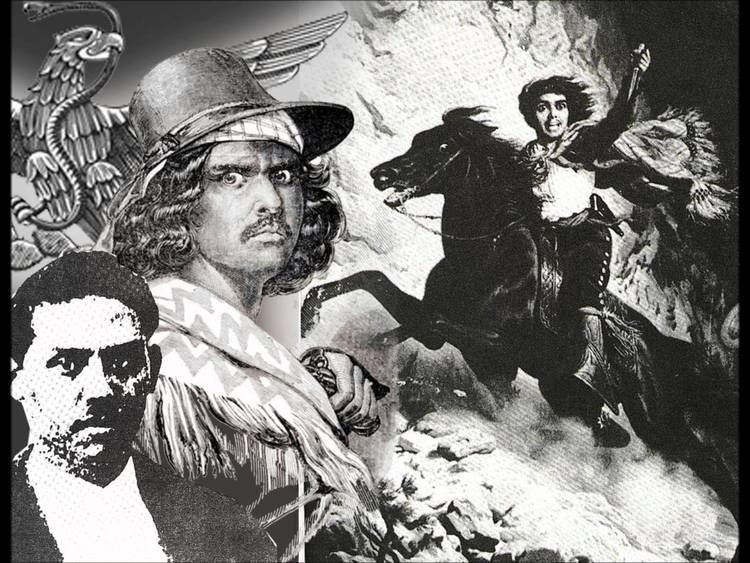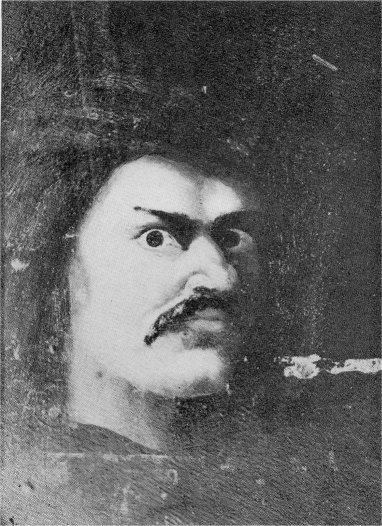Cause of death Decapitation Spouse Rosa Feliz Name Joaquin Murrieta | Occupation Gold Miner, Outlaw Nationality Mexican | |
 | ||
Other names The Robin Hood of El Dorado, The Mexican Robin Hood Parent(s) Joaquin and Rosalia (nee Carillo) Murrieta Residence California, United States, Sonora, Mexico, Mexico | ||
The head of joaquin murrieta
Joaquin Murrieta Carrillo (sometimes spelled Murieta or Murietta) (1829 – July 25, 1853), also called the Mexican Robin Hood or the Robin Hood of El Dorado, was a famous figure in California during the California Gold Rush of the 1850s. Depending on the point of view, he was considered as either an infamous bandit or a Mexican patriot.
Contents
- The head of joaquin murrieta
- Controversy over his life
- Early life and education
- Migration to California
- The Real Zorro
- Representations in media
- Joaquin murrieta history channel
- References

In 1919 Johnston McCulley supposedly received his inspiration for his fictional character Don Diego de la Vega better known as Zorro from the 1854 book entitled The Life and Adventures of Joaquín Murieta: The Celebrated California Bandit by John Rollin Ridge. John heard about a Mexican miner who had turned to banditry and was intrigued by the story.

Controversy over his life

Controversy surrounds the figure of Joaquin Murrieta: who he was, what he did, and many of his life's events. This is summarized by the words of historian Susan Lee Johnson:

"So many tales have grown up around Murrieta that it is hard to disentangle the fabulous from the factual. There seems to be a consensus that Anglos drove him from a rich mining claim, and that, in rapid succession, his wife was raped, his half-brother lynched, and Murrieta himself horse-whipped. He may have worked as a monte dealer for a time; then, according to whichever version one accepts, he became either a horse trader and occasional horse thief, or a bandit."
John Rollin Ridge, grandson of the Cherokee leader Major Ridge, wrote a dime novel about Murrieta; the fictional biography contributed to his legend, especially as it was translated into various European languages. A portion of Ridge's novel was reprinted in 1858 in the California Police Gazette. This story was picked up and subsequently translated into French. The French version was translated into Spanish by Roberto Hyenne, who took Ridge's original story and changed every "Mexican" reference to "Chilean" for either nationalistic reasons or to better fit the Chilean market.
Early life and education
Most biographical sources hold that Murrieta was born in Hermosillo in the northwestern state of Sonora, Mexico. However, "evidence suggests . . . [he] was not one man, but three, or five, whose exploits were recorded as one."
Migration to California
Murrieta reportedly went to California in 1849 to seek his fortune in the California Gold Rush. He encountered racism in the extreme competition of the rough mining camps. While mining for gold, he and his wife supposedly were attacked by American miners jealous of his success. They allegedly beat him and raped his wife. However, the source for these events is not considered reliable, as it was a dime novel, The Life and Adventures of Joaquín Murieta, written by John Rollin Ridge and published in 1854.
The historian Frank Latta, in his twentieth-century book, Joaquín Murrieta and His Horse Gangs (1980), wrote that Murrieta was from Hermosillo in the northern Mexican state of Sonora, and that he had a paramilitary band made up of relatives and friends. Latta documented that they regularly engaged in illegal horse trade with Mexico, and had helped Murrieta kill at least six of the Americans who had attacked him and his wife.
He and his band attacked settlers and wagon trains in California. They also stole horses, driving them from Contra Costa County to the Central Valley via the remote La Vareda del Monte trail through the Diablo Range. The gang is believed to have killed up to 28 Chinese and 13 Anglo-Americans. By 1853, the California state legislature considered Murrieta enough of a criminal to list him as one of the so-called "Five Joaquins" on a bill passed in May 1853. The legislature authorized hiring for three months a company of 20 California Rangers, veterans of the Mexican-American War, to hunt down "Joaquin Botellier, Joaquin Carrillo, Joaquin Muriata [sic], Joaquin Ocomorenia, and Joaquin Valenzuela," and their banded associates. On May 11, 1853, the governor John Bigler signed an act to create the "California State Rangers," to be led by Captain Harry Love (a former Texas Ranger and Mexican War veteran).
The state paid the California Rangers $150 a month, and promised them a $1,000 governor's reward if they captured the wanted men. On July 25, 1853, a group of Rangers encountered a band of armed Mexican men near Arroyo de Cantua on the edge of the Diablo Range near Coalinga, California. In the confrontation, three of the Mexicans were killed. They claimed one was Murrieta, and another Manuel Garcia, also known as Three-Fingered Jack, one of his most notorious associates. Two others were captured. A plaque (California Historical Landmark #344) near Coalinga at the intersection of State Routes 33 and 198 now marks the approximate site of the incident.
As proof of the outlaws' deaths, the Rangers cut off Three-Fingered Jack's hand, and the alleged Murrieta's head, and preserved them in a jar of alcohol to bring to the authorities for their reward. Officials displayed the jar in Mariposa County, Stockton, and San Francisco. The Rangers took the display throughout California; spectators could pay $1 to see the relics. Seventeen people, including a Catholic priest, signed affidavits identifying the head as Murrieta's, alias Carrillo.
Love and his Rangers received the $1,000 reward money. In August 1853, an anonymous Los Angeles-based man wrote to the San Francisco Alta California Daily that Love and his Rangers murdered some innocent Mexican mustang catcher, and bribed people to swear out affidavits. Later that fall, California newspapers carried letters by a few men claiming that Capt. Love had failed to display Murrieta's head at the mining camps, but this was not true. On May 28, 1854, the California State Legislature voted to reward the Rangers with another $5,000 for their defeat of Murrieta and his band.
But, 25 years later, the myths began to form. In 1879, O. P. Stidger was reported to have heard Murrieta's sister say that the displayed head was not her brother's. At around the same time, numerous sightings were reported of Murrieta as an old man. These were never confirmed. His preserved head was destroyed during the 1906 San Francisco earthquake and subsequent fire. His head is displayed prominently in the Cosmopolitan Hotel in Old Town San Diego, so there are doubts to whether his preserved head, in fact, still exists.
The Real Zorro
Murrieta's nephew, known as Procopio, became one of California's most notorious bandits of the 1860s and 1870s; he purportedly wanted to exceed the reputation of his uncle. Murrieta was possibly partly the inspiration for the fictional character of Zorro, the lead character in the five-part serial story, "The Curse of Capistrano," written by Johnston McCulley, and published in 1919 in a pulp fiction magazine. For some activists, Murrieta had come to symbolize the resistance against Anglo-American economic and cultural domination in California. The "Association of Descendants of Joaquin Murrieta" says that Murrieta was not a "gringo eater," but "He wanted to retrieve the part of Mexico that was lost at that time in the Treaty of Guadalupe Hidalgo."
Representations in media
Joaquin Murrieta has been a widely used romantic figure in novels, stories, and films, and on TV.
Literature:
Film and TV:
Music:
